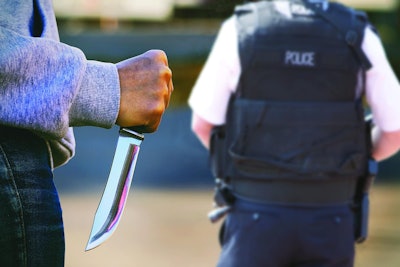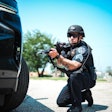 With most knife attacks, the assailant waits until the officer is distracted or vulnerable and then quickly executes a violent burst of repetitive stabs, leaving the officer with little time to react.Photo: Getty Images
With most knife attacks, the assailant waits until the officer is distracted or vulnerable and then quickly executes a violent burst of repetitive stabs, leaving the officer with little time to react.Photo: Getty Images
The best defensive tactics for countering knife attacks has been a topic of much debate, with hundreds of techniques and opinions on the matter. Based on research regarding how spontaneous knife attacks typically unfold, my agency conducted an instructional experiment within a controlled training environment to better understand the natural response officers have when suddenly attacked by knife. My theory was that by applying basic principles of fighting, officers could increase their chances of success and survivability.
The reality of knife attacks and even knife attacks against law enforcement is that most occur when the attacker executes a violent burst of repetitive stabs from various angles. The attacker conceals the weapon and waits until the officer is distracted or vulnerable. They then launch an abrupt and violent attack on the officer, leaving them caught off guard and with little time to react. By then it is too late, and the target of the attack finds they have been stabbed numerous times before they attempt to take action. Often they believe the attack was a series of punches until they realize they have been seriously injured.
According to an analysis of over 150 knife attacks caught on film completed by Urban Fit and Fearless (https://www.urbanfitandfearless.com/2016/09/self-defence-against-knife-attacks.html), the offender usually leads the attack with their non-knife hand about 71% of the time. Once the attack has been initiated, about 80% of offenders latch onto the target to control distance and mitigate escape. In the instance that the target can make a backward escape, half the time they ended up falling, and were not successful with launching a counterattack before the offender landed a stab. These components of the fight and how often they occur seem to be conclusive with most footage and research on this topic.
Attack Scenario
As a defensive tactics instructor, I have placed students in many types of vulnerable positions and asked them what they would do if the suspect spontaneously pulled a deadly weapon on them. The overwhelming response is, "I'd just shoot them." Officers are then shown why this is not an acceptable answer with a multitude of hands-on scenarios.
To test how officers would instinctively react to a spontaneous knife attack, my agency conducted a simulation during an in-service defensive tactics training. Ninety-one officers with varied levels of experience were put through this scenario and attacked with a trainer knife that displays audible and visual responses to slashes and stabs. This tool was invaluable for this scenario and made it obvious when the officer was cut. While different techniques and systems of fighting could be reinforced during a similar training scenario, we found the training knife (an Aku Strike Mimic T-16) to be highly effective during the simulation.
Initially officers met outside of a shooting simulator room and were told they were being dispatched to a suspicious person call. They were told they would meet the complainant inside, which led them to approach and initiate conversation within the average distance they would normally keep while conducting business, a range of three or less than three feet. The officers entered the room and engaged in a dialogue with the complainant, and the screen of the simulator would divert their attention. The complainant then attacked with the training knife. The attacker latched onto the officer with his free hand while launching repetitive and aggressive stabs toward the mid-section. Over the course of the simulation, the attacker was able to latch onto the officer's clothing in every scenario, which restricted their ability to create distance.
Officer Response
Nine of the officers instinctively attempted to close the distance and address the knife. They were stabbed an average of 5.2 times before they were able to disarm the suspect or draw their weapon and end the threat.
The remaining 82 of the officers moved directly backward, attempting to create distance. They were stabbed an average of 6.5 times before they were able to draw their weapon and end the threat. Roughly 40% of those lost their footing or fell on the ground.
None of the 91 officers made a truly lateral movement out of instinct. Some angled away slightly while going forward or backward, but none made an aggressive lateral movement to avoid the attack. Out of the 91 participating officers, only one did not get stabbed at all. He successfully intercepted the attack and was able to draw and fire his weapon without sustaining any damage.
After the scenario was complete, all participating officers debriefed training instructors on what their thoughts were during the course of the attack. Nearly all of them said they were caught completely off guard and that they didn't really realize what was happening until they had been stabbed multiple times.
Lateral Movement
After debriefing, all officers were then trained in an alternative response with two components. One singular technique was shown for blocking and/or trapping the knife hand, and then officers were shown the value in making an aggressive lateral movement when attacked. The exercises were repeated several times before officers attempted the simulation again, with emphasis mainly on the importance of making a lateral movement.
As the element of surprise was impossible to recreate, the scenario began with the attacker already latched onto the officer and the knife already out. This led to much less reaction time for the officers. During the exercise, all officers made an aggressive lateral movement. Some of them trapped the attacker's knife hand, while some officers went immediately to their weapon. Officers were left unrestricted with how they chose to respond. During this session, though all officers were stabbed, on average they were only stabbed about 1.5 times before ending the threat.
While this decreased number of stabs cannot be accurately compared to the average number of stabs received during the first scenario, it does support the theory that lateral movements win fights. This is a principle widely believed to be true in gunfights, fistfights, ground fights, knife fights, and so on. When we fight in angles, we increase our chance of survival.
The reality remains that knife attacks are brutal and deadly. Even with highly developed skills, the likelihood of being injured is very high. However, based on these preliminary trials, it seems that if officers condition their instinctual reaction to be a lateral movement when a threat presents itself, they will have a greater chance of survival during a spontaneous knife attack.
Sgt. Clay Culpepper is a defensive tactics and firearms instructor with the Marietta (GA) Police Department. He is a former sniper team leader and current entry team leader on the department's SWAT team. His experience includes special units with narcotics, training, and hiring. He is also an IALEFI instructor.















